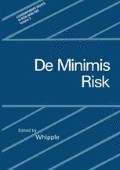Abstract
Several attempts have been made to use the variation in the levels of natural background radiation to define an acceptable level risk for man-made radiation. The philosophical basis for such proposals is that since no correlations have been detected between variations in natural background radiation and adverse health effects, small additions to natural exposure should be acceptable. The difficulty lies in defining “small.” In 1978, Adler and Weinberg proposed using the standard deviation of background radiation levels as a method for establishing radiation exposure limits (Adler and Weinberg 1978). The Adler and Weinberg proposal results in the suggestion that a lifetime cancer risk of about 10−4 is de minimis.* The Adler and Weinberg de minimis risk level was based on the standard deviation of human exposure to background terrestrial and cosmic radiation. We propose to determine the risk levels associated with the standard deviation of human exposure to other radioactive and chemical carcinogens.
Access this chapter
Tax calculation will be finalised at checkout
Purchases are for personal use only
Preview
Unable to display preview. Download preview PDF.
References
Adler, H. I. and A. M. Weinberg, “An Approach to Setting Radiation Standards,” Health Physics 34: 719–720, (June 1978).
Air Resources Board and Department of Human Services, Report to the Scientific Review Panel on Benzene, (November 1984).
Bogen, K. T. and A. S. Goldin, Population Exposure to External Natural Radiation Background in the United States 1960–2000,Environmental Protection Agency ORP/CSD 72–1 (August 1981).
Carcinogen Assessment Group, “Relative Carcinogenic Potencies among 53 Chemicals Evaluated by the Carcinogen Assessment Group as Suspect Human Carcinogens,” U.S. Environmental Protection Agency (October 1984).
Canadian Radiation Protection Bureau, “Section on Uranium from the Canadian Radiation Protection Bureau, Guidelines for Canadian Drinking Water Quality,” supporting documentation to Health and Welfare, Ottawa, Canada (1980).
Cothern, R. C., “Techniques for the Assessment of Carcinogenic Risk Due to Drinking Water Contaminants” CRC Critical Reviews in Press: 32, (October 17, 1985).
Cothern, R. C., and W. L. Lappenbusch, “Occurrence of Uranium in Drinking Water in the U.S.,” Health Physics 45(1): 89–99, (July 1983).
Cothern, R. C., W. L. Lappenbusch and J. A. Cotruvo, “Health Effect Guidance for Uranium in Drinking Water,” Health Physics 44(1): 377–384, (1983).
Cothern, R. C., W. L. Lappenbusch and J. Michel, “Drinking Water Contribution to Natural Background Radiation,” Health Physics 50(1): 33–47, (January 1986).
Drury, J. S., S. Reynolds, P. T. Owen, R. H. Ross and J. T. Ensminger, “Uranium in the U.S. Surface, Ground, and Domestic Waters,” U.S. Environmental Protection Agency, EPA–570/9–81–001 (1981). Environmental Protection Agency, “Notice of Proposed Maximum Contaminant Levels of Radioactivity,” U.S.
Environmental Protection Agency, Federal Register 40: 34324, (1975).
Environmental Protection Agency, “Formaldehyde Determination of Significant Risk,” Federal Register 49: 21870, (May 1984).
Evans, R. D., J. H. Harley, W. Jacobi, A. S. McLean, W. A. Mills and C. G. Stewart, “Estimate of Risk from Environmental Exposure to Radon-222 and its Decay Products,” Nature 290 (March 1981)
Hawthorn, A. R., R. B. Gammage, C. S. Dudney, B. E. Hingerty, D. D. Schuresko, D. C. Parzyck, D. R. Womack, S. A. Morris, R. R. Westley, D. A. White, and J. M. Schrimsher, An Indoor Air Quality Study of Forty East Tennessee Homes, Oak Ridge National Laboratory, ORNL-5965 (December 1984).
Michel, J. and W. S. Moore, “228Ra and226Ra content of groundwater in fall line aquifers,” Health Physics 38: 336–671, (1980).
National Academy of Sciences, National Research Council, The Effects on Populations of Exposures to Low Levels of Ionizing Radiation, BEIR-1 (1972).
National Academy of Sciences, National Research Council, The Effects on Populations of Exposures to Low Levels of Ionizing Radiation, BEIR-3 (1980).
National Council on Radiation Protection, Evaluation of Occupational and Environmental Exposures to Radon and Radon Daughters in the United States, NCRP Report 78 (1984).
Nero, A. V., “Indoor Concentrations of Radon 222 and Its Daughters: Sources, Range, and Environmental Influences,” Indoor Air and Human Health, ed. by R. B. Gammage and S. V. Kaye, Lewis Publishers, Chelsea, Mich., 43–67, (1985).
Nuclear Regulatory Commission, Safety Goals for Nuclear Power Plant Operations, U. S. Nuclear Regulatory Commission NUREG-0880, Rev. 1 (May 1983).
Nuclear Regulatory Commission, Proposed Revision of 10 CFR Part 20, “Standard Protection Against Radiation,” U.S. Nuclear Regulatory Commission SECY-85–147-Part 1 (April 1985).
Oakley, D. T., Natural Radiation Exposure in the United States, Office of Radiation Programs, Environmental Protection Agency (1972).
Oswald, R. W., “Indoor Radon Results in the United States,” Terradex Corporation (June 1984).
Symons, J. M., A. Thomas, J. Bailor, C. Keith, J. DeMarco, K. K. Kropp, G. G. Robeck, D. R. Seeger, C. J. Slocum, B. L. Smith and A. A. Stevens, “National Organics Reconnaissance Survey for Halogenated Organics,” Journal AWWA: 634— 652, (November 1975).
Travis, C. C., S. A. Richter, E.A.C. Crouch, R. Wilson, and E. Klema, “Cancer Risk Management”, Environmental Science and Technology 21:415–420, (1987).
Turekian, K. K. and L. H. Chen, “The Marine Geochemistry of Uranium Isotopes, 230Th and 231Pa, Activation Analysis,” Geochemistry and Cosmochemistry, ed. by A. O. Brunfelt and E. Steinnes, UNIVERSITETSPOR-LAGET, Oslo-Berger-Tromso (1971).
United Nations Scientific Committee of the Effects of Atomic Radiation, “Ionizing Radiation: Sources and Biological Effects,” 19, U.N., New York (1982).
Watson, A. P., E. L. Etnier and L. M. McDowell-Boyer, Radium-226 in Drinking Water and Terrestrial Food Chains: A Review of Parameters and an Estimate of Potential Exposure and Dose, ORNL/TM-8597 (1983).
Author information
Authors and Affiliations
Editor information
Editors and Affiliations
Rights and permissions
Copyright information
© 1987 Plenum Press, New York
About this chapter
Cite this chapter
Travis, C.C., Richter, S.A. (1987). On Defining a De Minimis Risk Level for Carcinogens. In: Whipple, C. (eds) De Minimis Risk. Contemporary Issues in Risk Analysis, vol 2. Springer, Boston, MA. https://doi.org/10.1007/978-1-4684-5293-8_6
Download citation
DOI: https://doi.org/10.1007/978-1-4684-5293-8_6
Publisher Name: Springer, Boston, MA
Print ISBN: 978-1-4684-5295-2
Online ISBN: 978-1-4684-5293-8
eBook Packages: Springer Book Archive

